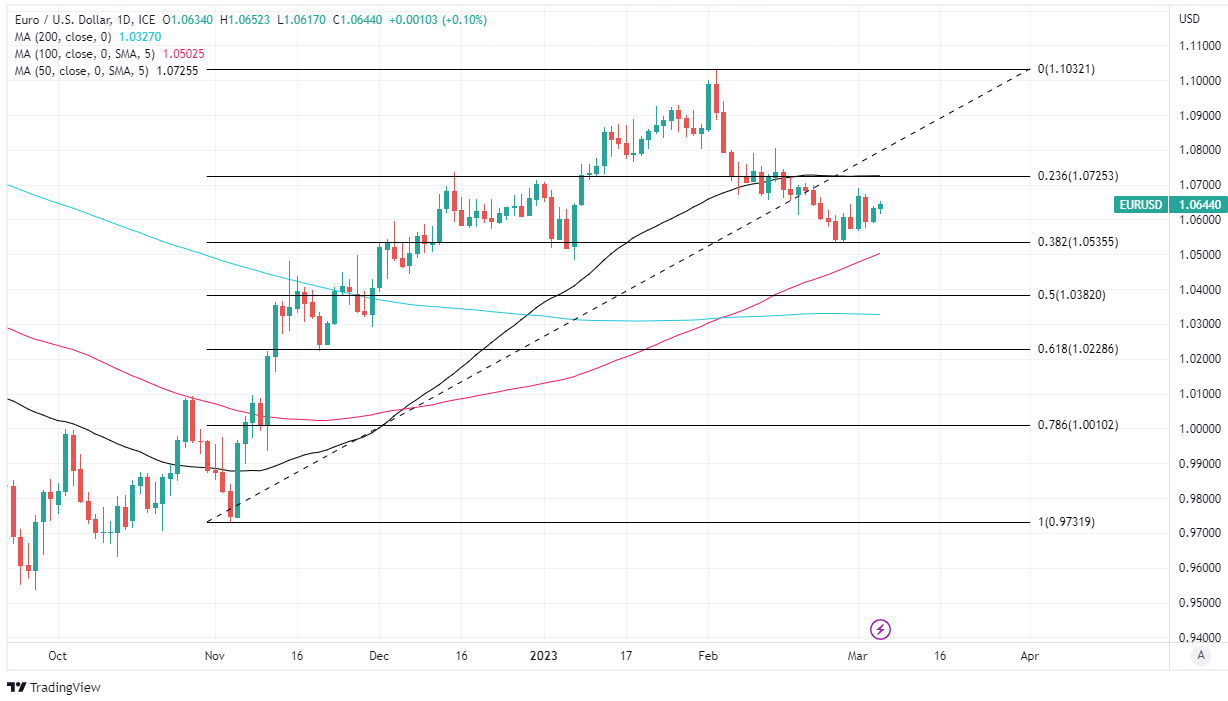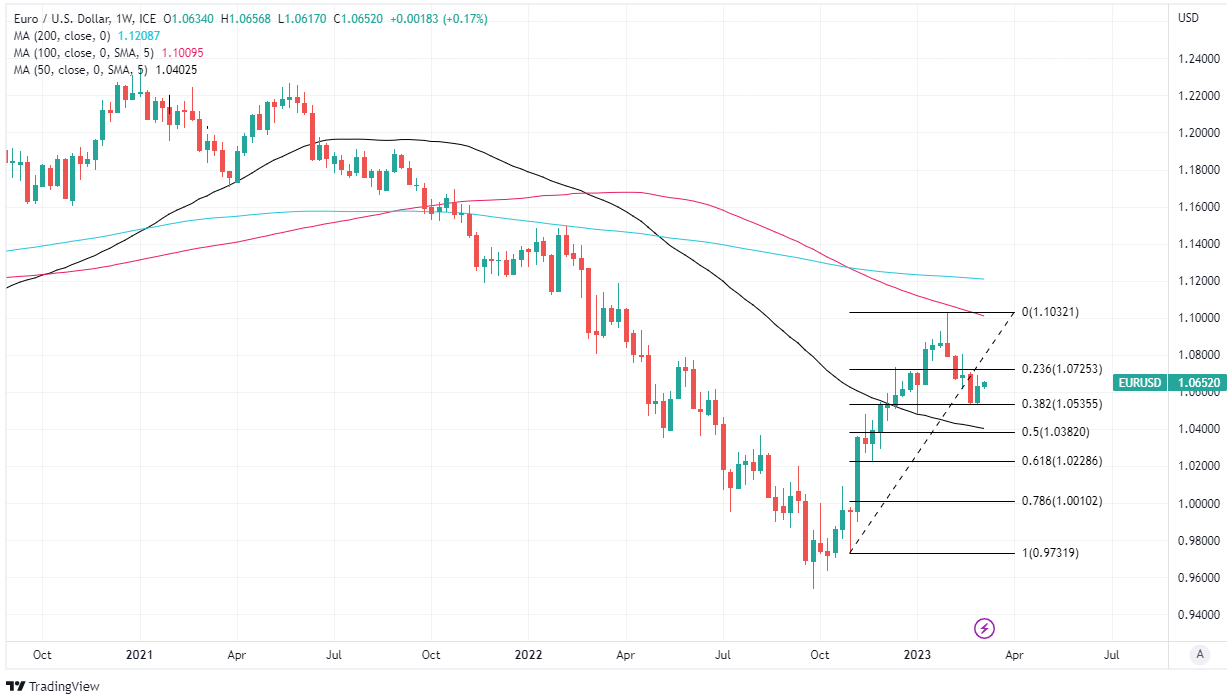EUR/USD Week Ahead Forecast: Helped by ECB as U.S. and China Eyed
- EUR/USD supported near 1.0535 & 1.0502 further down
- ECB stance, possible China stimulus could lift EUR/USD
- Chart resistance risks sapping momentum around 1.0725
- Hawkish Fed stance & resilient U.S. economy also eyed

© European Central Bank, reproduced under CC licensing
The Euro to Dollar exchange rate appeared to draw a line under its February losses last week but would likely need the benefit of stronger international tailwinds if it is to sustain any recovery beyond a nearby technical resistance around 1.0725 on the charts over the coming days.
Europe's single currency edged higher against a docile Dollar throughout last week after S&P Global PMI surveys suggested an early thawing of the winter frost on the economic ground across much of the continent while the Euro also appeared to benefit from the European Central Bank (ECB) policy stance.
"What I am certain about is that we will return to our 2% target in a timely manner and that we will be resolute and determined in doing so," President Christine Lagarde told Spain's El Correo newspaper at the weekend.
"The ECB doesn’t have a ceiling, but an inflation target of 2%. That is the medium-term inflation target, which is how price stability is defined for us. As I said, I cannot tell you how high rates will go. I know that they will be higher than they are now and we still have more work to do because we cannot declare victory. We are making progress, but we still have work to do," she said when asked how high borrowing costs might ultimately be raised.
One other factor helping the Euro in recent trade has been an uplift in market-implied expectations for the ECB deposit rate, which suggest that particular benchmark is now widely seen as likely to reach the 4% handle by year-end.
 Above: Euro to Dollar rate at daily intervals with Fibonacci retracements of November rally indicating possible areas of technical support while selected moving averages denote prospective supports and resistances. Click image for closer inspection. To optimise the timing of international payments you could consider setting a free FX rate alert here.
Above: Euro to Dollar rate at daily intervals with Fibonacci retracements of November rally indicating possible areas of technical support while selected moving averages denote prospective supports and resistances. Click image for closer inspection. To optimise the timing of international payments you could consider setting a free FX rate alert here.
This is after Eurostat figures suggested last Thursday that Europe's core inflation rate rose from 5.3% to 5.6% during a February defiance of both gravity and market expectations, marking a potentially troublesome divergence with the overall or headline rate of inflation.
"Persistently elevated inflation sets the stage for significant monetary tightening beyond the March ECB meeting. Soft and hard data continue to send contrasting signals on the strength of activity," writes Silvia Ardagna, chief Europe economist at Barclays, in a Friday research briefing.
"We now expect the ECB to raise rates by 50bp in both March and May, before stepping down to 25bp in June and July. We expect that the ECB will remain on hold with the deposit rate at 4.0% (3.5% previously) until H2 24, when it will cut policy rates cumulative by 100bp," she adds.
Europe's overall or headline rate of inflation dipped slightly when falling from an upwardly-revised 8.6% to 8.5% in February but it's the core inflation that is likely to matter more for ECB policymakers because it is widely viewed as more representative of price pressures generated within the domestic economy.
Stubborn inflation and rising market expectations for interest rates are part of why Monday's address from ECB Chief Economist Philip Lane is likely to be listened to closely by the market but other factors including U.S. economic data and developments in China are also likely to matter for the Euro this week.
Above: Financial model-derived estimates of probable trading ranges for selected currency pairs this week. Source Pound Sterling Live. (If you are looking to protect or boost your international payment budget you could consider securing today's rate for use in the future, or set an order for your ideal rate when it is achieved, more information can be found here.)
"EUR/USD can lift this week if the USD eases as we expect. January’s Eurozone retail sales volumes can bounce following a large 2.7% fall in December," writes Joseph Capurso, head of international economics at Commonwealth Bank of Australia, in a Monday research briefing.
"However we expect the downward trend in retail sales volumes to remain intact with high inflation and rising interest rates weighing on demand. There is upside support for EUR/USD at 1.0798 (76.4% Fibbo). AUD/EUR can head towards its recent cyclical low of 0.6259 if the RBA is dovish this week," he adds.
One potentially important influence for the Euro is whether the Chinese government announces any stimulus to support the pursuit of the more-modest-than-usual GDP growth target revealed at the opening of the annual Two Sessions meeting of lawmakers over the weekend.
With this aside much attention is likely to be directed toward the U.S. calendar and Washington where Federal Reserve (Fed) Chairman Jerome Powell's Tuesday and Wednesday appearances in Congress will be in focus going into the publication of important labour market figures.
The labour data includes the January edition of the Job Openings and Labor Turnover Survey (JOLTS) and February's non-farm payrolls report, which will be scrutinised closely in light of the extent to which wage pressures resulting from the tight labour market are driving the Fed's interest rate stance.
 Above: Euro to Dollar rate shown at weekly intervals with Fibonacci retracements of November rally indicating possible areas of technical support while selected moving averages denote prospective supports and resistances for the single currency. To optimise the timing of international payments you could consider setting a free FX rate alert here.
Above: Euro to Dollar rate shown at weekly intervals with Fibonacci retracements of November rally indicating possible areas of technical support while selected moving averages denote prospective supports and resistances for the single currency. To optimise the timing of international payments you could consider setting a free FX rate alert here.

